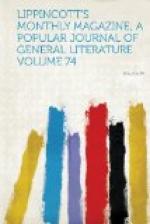[Footnote 003: Madame Rattazzi is now living in Paris, in the little palace once inhabited by the duke d’Aquila, in the Cour de la Reine, where she entertains the literary and artistic world once a week. Her soirees this year are becoming famous. Recently she acted in Ponsard’s Horace et Lydie and in other little comedies, assisted by the greatest actors and actresses of Paris including Mesdames Favart and Roussel, but according to universal testimony her own performance was by far the finest. Never has Madame Rattazzi been so popular as at present, and her salon is frequented by all the celebrities of the French capital, to whom she extends the most charming hospitality.]
[Footnote 004: This refers to the Gospodi pomiloui (the Roman Catholic Kyrie eleison), which perpetually recurs in the Russian liturgy. Similar discussions about the Hallelujah and other liturgic forms are met with long before the Raskol broke out.]
[Footnote 005: If we may trust Dmitri of Rostof, a bishop of the last century, even so early certain sectaries regarded the raising of Lazarus as not a fact, but a parable: “Lazarus is the human soul, and his death is sin. His sisters, Martha and Mary, are the body and the soul. The tomb represents the cares of this life, and his raising from the dead is conversion. Similarly, Christ’s entry into Jerusalem sitting on an ass is a mere parable.”]
[Footnote 006: The analogy must certainly be admitted to lie very far from the surface.—(Note of the Translator.)]
[Footnote 007: The opposition of some of the Raskolniks to this tax (which has lately been modified) was rendered more determined by the fact that in the interval between one census and another the tax continued to be paid for “dead souls.” Gogol’s novel is founded on this. From its being nominally levied on the dead, this tax was regarded by these simple people as a sacrilege.]
[Footnote 008: To combat this notion, an orthodox bishop, Dmitri of Rostof, wrote a treatise on the image and likeness of God. A Raskolnik told this prelate, “We would as lief lose our heads as our beard.”—“Will your heads grow again?” was the bishop’s retort.]
[Footnote 009: “But here’s the joy, my friend and I are one...”]



